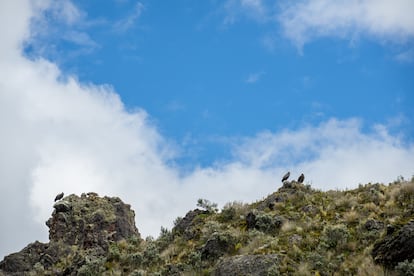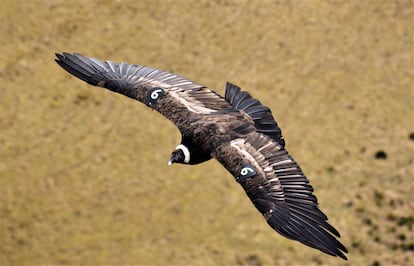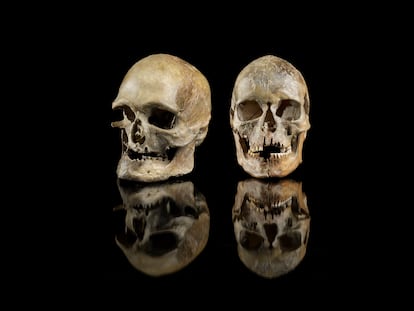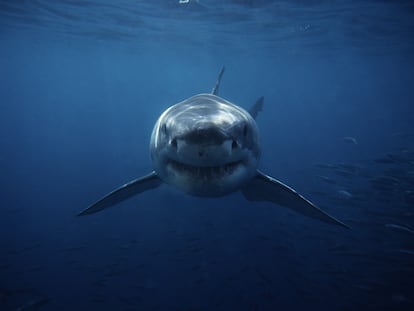The culturally significant Andean condor is at risk of extinction
Associated with ideas of power and immortality, the bird occupies a prominent place in the popular imagination, but its population is at worrying figures. A sanctuary in Ecuador is fighting for the animal’s conservation

In 2011, the Chakana Reserve, a former cattle ranch, became an important conservation site for Andean flora and fauna. It is one of a network of 15 private reserves created by the Locofoco Conservation Foundation. Located 60 kilometers southeast of Quito, Ecuador, it has 5,000 hectares and is flanked by an ancient wall of lava flow once expelled by the Chakana volcano, which neighbors Antisana, a major volcano that rises near the bottom of this area. The site is surrounded by the largest paramos (high plateaus) in Ecuador. The reserve extends from the road to behind the mountains. Among other animals, the reserve is home to spectacled bears, pumas, mountain tapirs, white-tailed deer and peregrine falcons.
But above all, the Chakana Reserve is known as an Andean condor sanctuary. 40 of Ecuador’s barely 150 condors live in this area and its environs, according to the most recent study, conducted in 2018. According to Peru’s National Forest and Wildlife Service, there are 301 condors in that country, and the International Union for the Conservation of Nature (IUCN) estimates that there are 1,500 and 2,000 specimens in Chile and Argentina, respectively. According to the Wildlife Conservation Society (WCS), Bolivia has between 80 and 150 condors, and Fundación Neotropical’s 2021 survey in Colombia found that at least 63 reside in that country.

The high concentration of individual condors in the Chakana Reserve—which is crucial for the survival of this endemic species that does not share genetic material with the birds of neighboring countries—makes it the most important site of its kind, not just in Ecuador but in all of northern South America. The largest flying bird in the world (its wingspan can exceed three meters and it can weigh up to 15 kilograms), the condor is an important symbol in Ecuador; it graces the national coat of arms as a symbol of greatness and represents ideas of power and health that stem from the cosmovision of many different Andean cultures.
But the condor is in danger of extinction. “A healthy population of a closed species like Ecuador’s [condor], which does not share genetic material with the ones in Colombia and Peru, should have between 600 and 700 breeding pairs so that the species’ survival can be guaranteed 100 years from now,” explained Fabricio Narváez, the executive director of the Ecuador Andean Condor Foundation. “But now we [only] have between 40 and 60 breeding pairs, which shows how serious the condor’s situation is at the national level.”
It was an early Saturday morning in February and the sky over the reserve was a crystal-clear light blue. We stopped at the side of the road at a lookout to observe the Isco crag, an impressive two-kilometer-long stone wall where several condors in the area live, nest and roost. The country’s most prolific pair of condors has been living there since 2012; the couple has had one offspring per year since that time, as compared with the normal rate of reproduction of every two or three years. A wide and dense paramo bed extends at the foot of the crag; it is lined with achupallas, a ground bromeliad that feeds the spectacled bears that roam the area. We weren’t lucky enough to see them, but at around 9:30 a.m. we saw the first condors of the day, two young birds (gray plumage, brown spots) in calm flight.

Collecting data, protecting condors and debunking myths
In the heart of the reserve, the paramo is no longer what one sees in front but rather what is underfoot. All around, a group of white-tailed deer leap as if in a cartoon, while a pair of Andean egrets splash in a waterhole. The ground is carpeted with dandelion flowers, and higher up a former cattle pasture is now a healthy patch of grass. Luis Gualotuña, a biologist at the Andean Condor Foundation, an organization that works closely with the Chakana Reserve, ate a snack while he watched the flight of the condors; four or five of them glid over the rock. His goal was to catch one so that he can attach a satellite tracker and wing band to it.
There are several techniques for attracting them, including using carrion or captive condors. When the lured condors approach, they can be captured by using snares or nets. Researchers then measure and take blood samples from the birds to determine their genetic profile; the condors are then fitted with a satellite tracker and a wing band so scientists can identify them from a distance. The process usually takes thirty minutes and then the bird is released. But that day Gualotuña was unable to place band number 20. To date, 16 trackers have been placed with their corresponding wing bands; another three condors have bands only.
“We started placing trackers and wing bands to mark the condors, and that revolutionized our knowledge about the species,” said Sebastián Kohn, the founder of Cóndor Andino (Andean Condor) and its current president. In 2012, the young biologist accompanied Hernán Vargas, an Ecuadorian biologist with a PhD from Oxford University who—as a member of the Peregrine Fund, a U.S. organization dedicated to conserving endangered birds of prey—came to Ecuador to start the most comprehensive study on the condor at that time. Together, they went to the Chakana Reserve and were greeted by a dazzling scene: some 20 condors were devouring a horse carcass.
“I had never seen so many condors; they flew very close to us, and then I had an epiphany: I realized that we knew nothing about them,” Kohn said. Until then, experts commonly thought that simply breeding condors in captivity and then releasing them into the wild represented the solution for the species’ decline. “But no one had stopped to investigate how many condors exist, where and how they live, that is, the basics,” he added.

With financing from the Peregrine Fund, the two biologists began their research; a veterinarian and two other biologists also came on board to form the initial team of investigators. Technology allowed them to learn about the condor’s breeding, mortality, flight and movement patterns. Researchers went from not knowing anything to learning the rocks on which the birds settle to eat or sleep; from knowing about a single nest to finding the location of 30; from knowing about 32 roosts to having a database of over 500 across the entire mountain range. Similar research had been done in Chile and Argentina, but the researchers in Ecuador were the first to do so in northern South America. Years later, in 2017, they established the Fundación Cóndor Andino Ecuador (Ecuador Andean Condor Foundation). Today, the organization works on 12 flora and fauna conservation projects around the country.
With the data they collected, the researchers were also able to debunk some myths. For instance, many biologists previously maintained that it was impossible for the condor to kill another animal for food, based on the belief that the birds only feed on carrion. However, field researchers said that they had witnessed one condor arrive and bite a calf from the front, for example, while another came from behind to attack the bovine with its beak and claws. Monitoring the birds allowed scientists to verify and document such attacks. Previously, a lack of food was thought to be the main threat facing the condor, a bird that can eat up to five kilograms of meat a day and survive up to five weeks without food.
To test that idea, scientists put down carrion, hoping that the condors would eagerly pounce on it. But to their surprise, they saw that the condors did not stop because they had already eaten. However, the feral dogs that invade Ecuador’s paramos went for the carcasses, and scientists realized that they are a primary threat to the condor. A 2015 Wildlife Conservation Society study in Ecuador estimated that 50,000 feral dogs roamed the highland mountains. Today, it is believed that there are twice as many canines in the area.
The primary threats of feral dogs and a wind farm
Narváez explained that feral dogs are the main food competitors for the entire scavenger chain, including condors, paramo wolves (Andean foxes) and curiquingues. The dogs also displace and kill native species and transmit zoonotic diseases like canine distemper. In addition, wild dogs also attack the corrals of poor peasant families for whom their animals (chickens, calves, sheep, guinea pigs) serve as both food and a source of income. The owners of these animals set traps with poisoned carrion to kill the dogs, and eventually condors arrive to eat the carcasses of the dogs killed by poisoning, leading to a quagmire of unstoppable proportions.
“Solving that problem is extremely complex,” Kohn said. “We have to involve Ecuadorian society as a whole, because it starts with abandoning dogs in the countryside. We have to educate [people] about responsible pet ownership, undertake massive sterilization campaigns and, in some places, we need to carry out campaigns to eradicate feral dogs. Many try to avoid talking about this issue, but it is something that must be done. [We have to] capture them and put them to death humanely.”

In addition, hunting continues to pose a considerable threat to the birds. Each year, the foundation rescues at least one bullet-wounded condor, but only one person has ever been prosecuted in Ecuador for hunting that animal. In 2013, a 61-year-old farmer hunted a young condor in Azuay province. Environmental and criminal regulations punish hunting endangered animals with up to five years in prison, but the poacher was only given six months because of a series of extenuating circumstances.
Other threats include an encroaching agricultural frontier, large-scale mining in concessioned paramos and condor foraging areas, and certain wind energy projects. On January 26, the last of the Huascachaca project’s 14 wind turbines was erected in the province of Loja, in the south of the country. The project is expected to produce 50 megawatts of energy per hour to power 90,000 Ecuadorian homes; it also promises to reduce the emission of some 76,000 tons of carbon dioxide. The issue is that these generators were built in front of a condor roost, that is, in their flight zone, and the birds could collide with the blades, which rotate at almost 200 kilometers per hour.
“What’s problematic is that the project’s environmental impact report doesn’t even mention the presence of those condors,” Kohn said. “It’s not a question of canceling that multibillion-dollar project. What we are proposing is that it take measures to mitigate [harm to the condors], that the report mention the condor’s presence in that region, and, for example, that they invest in a radar that reduces the speed of the turbines when it detects the flight of large birds.”
In 2009, Ecuador’s Ministry of Environment created the National Working Group on the Andean Condor as a coalition of organizations with expertise on the subject. The Jocotoco and Andean Condor Foundations are members. As the national authority, the Ministry of Environment is currently spearheading the process of implementing an action plan to conserve the emblematic bird. The approach includes research and monitoring, identifying threats, sustainable habitat maintenance, strengthening the wild population by reintroducing captive-bred birds, environmental education and raising awareness about the importance of the bird’s conservation. “The plan is being carried out to varying degrees of completion, and the authorities don’t really do any evaluation,” Kohn said. “But the biggest weakness is that there’s no budget for implementing [it], no support from the state.”
Looking west from the center of the Chakana Reserve, the horizon was a vast green tapestry of plots laid out with the grace of providential geometry. On such a clear day, the silhouettes of the Sincholagua, Rumiñahui and Pasochoa volcanoes appeared dto have the cadenced sequence of a waltz. We walke in that direction to where the plain ends, to perch atop the Isco crag, which we had previously seen from the roadside. All that was left to do was settle on that paramo ridge to wait for the splendid flight of the condors; the young ones have brown spots, while the adults bear white scarves and bare crests.
We watched them take off from their perches and roosts or arrive from behind, from another of the reserve’s crags, delighting us with their refined glide, the rhythmic oscillation of their tails, the constellations they call to mind when they fly in a group. Ten or more of them passed overhead, leading us to wish that these majestic birds—which can live for up to 80 years in captivity and several years less in the wild—remain on Earth for our children to see, despite the multiple threats the condor faces.
Sign up for our weekly newsletter to get more English-language news coverage from EL PAÍS USA Edition
Tu suscripción se está usando en otro dispositivo
¿Quieres añadir otro usuario a tu suscripción?
Si continúas leyendo en este dispositivo, no se podrá leer en el otro.
FlechaTu suscripción se está usando en otro dispositivo y solo puedes acceder a EL PAÍS desde un dispositivo a la vez.
Si quieres compartir tu cuenta, cambia tu suscripción a la modalidad Premium, así podrás añadir otro usuario. Cada uno accederá con su propia cuenta de email, lo que os permitirá personalizar vuestra experiencia en EL PAÍS.
¿Tienes una suscripción de empresa? Accede aquí para contratar más cuentas.
En el caso de no saber quién está usando tu cuenta, te recomendamos cambiar tu contraseña aquí.
Si decides continuar compartiendo tu cuenta, este mensaje se mostrará en tu dispositivo y en el de la otra persona que está usando tu cuenta de forma indefinida, afectando a tu experiencia de lectura. Puedes consultar aquí los términos y condiciones de la suscripción digital.
More information
Archived In
Últimas noticias
Most viewed
- Reinhard Genzel, Nobel laureate in physics: ‘One-minute videos will never give you the truth’
- Oona Chaplin: ‘I told James Cameron that I was living in a treehouse and starting a permaculture project with a friend’
- Pablo Escobar’s hippos: A serious environmental problem, 40 years on
- Why we lost the habit of sleeping in two segments and how that changed our sense of time
- Charles Dubouloz, mountaineering star, retires at 36 with a farewell tour inspired by Walter Bonatti










































